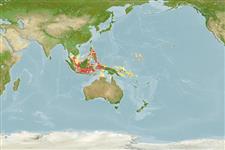>
Perciformes/Serranoidei (Groupers) >
Anthiadidae (Fairy basslets or Streamer basses)
Etymology: Pseudanthias: Greek, pseudes = false + Greek, anthias = a fish, Sparus aurata (Ref. 45335); charleneae: Name given to honour the request of HSH Prince Albert II of Monaco..
Environment: milieu / climate zone / depth range / distribution range
Ecologie
marien benthopelagisch; diepte 40 - 56 m (Ref. 74962). Deep-water
Western Pacific: Cenderawasih Bay, Indonesia.
Grootte / Gewicht / Leeftijd
Maturity: Lm ? range ? - ? cm
Max length : 7.5 cm SL mannelijk / geslacht onbekend; (Ref. 74962)
Dorsale stekels (totaal): 10; Dorsale zachte stralen (totaal): 16; Anale stekels 3; Anale zachte stralen: 7. This species is distinguished by the following characters: D X,16; A III,7; pectoral rays 17-18; lateral-line scales 47; gill rakers 11+ 25; moderately deep body, depth 2.4 in SL; papillae on posterior edge of orbit absent; fleshy protuberance at front of upper lip in males absent; vomerine teeth in a small triangular patch; third dorsal spine moderately elongate in males, 1.8 in HL; forked or lunate caudal fin, caudal concavity 1.4 in HL; in life, color of males mainly lavender pink with scattered orange flecks, grading to orange on head and anterodorsal part of body; a broad, tapering orange bar below middle of spinous dorsal fin, reaching to lower side; lavender-pink margined yellow band from snout tip to lower eye, continuing from lower rear corner of eye to pectoral-fin base; spinous dorsal fin lavender pink on basal half with broad yellow outer margin; soft dorsal fin mainly reddish orange, grading to yellow distally with narrow lavender-pink margin; anal fin mainly yellow with lavender pink anterior margin; caudal fin overall reddish orange with lavender submarginal band near tips of upper and lower lobes, the tips yellow-orange; pelvic fin yellow on anterior half and whitish posteriorly, with narrow lavender-pink anterior margin; pectoral fins translucent to slightly yellowish (Ref. 74962).
This species is rarely seen by divers due to its deep habitat. The holotype was collected on a steep rubble slope with abundant sea fans and was accompanied by about six smaller females (Ref. 74962). Forms aggregations (Ref 90102).
Levenscyclus en paargedrag
Maturiteit | Voortplanting | Paaien | Eieren | Fecunditeit | Larven
Allen, G.R. and M.V. Erdmann, 2008. Pseudanthias charleneae, a new basslet (Serranidae: Anthiinae) from Indonesia. aqua, Int. J. Ichthyol. 13(3-4):139-144. (Ref. 74962)
Status op de Rode Lijst van het IUCN (Ref. 130435)
Gevaar voor de mens
Harmless
Gebruik door de mens
Meer informatie
Lokale namenSynoniemenMetabolismePredatorenEcotoxicologieVoortplantingMaturiteitPaaienPaaiaggregatiesFecunditeitEierenOntwikkeling van de eieren
ReferentiesAquacultuurAquacultuurprofielKweeklijnenGeneticaElectrophoresesErfelijkheidZiektesVerwerkingNutrientsMassaconversie
Tools
Speciale rapporten
Download XML
Internetbronnen
Estimates based on models
Preferred temperature (Ref.
123201): 27.2 - 28.7, mean 27.9 °C (based on 5 cells).
Fylogenetische diversiteitsindex (Ref.
82804): PD
50 = 0.5000 [Uniqueness, from 0.5 = low to 2.0 = high].
Trofisch niveau (Ref.
69278): 3.3 ±0.4 se; based on size and trophs of closest relatives
Weerstandsvermogen (Ref.
120179): Hoog, minimale populatieverdubbelingstijd minder dan 15 maanden (Preliminary K or Fecundity.).
Fishing Vulnerability (Ref.
59153): Low vulnerability (10 of 100).
